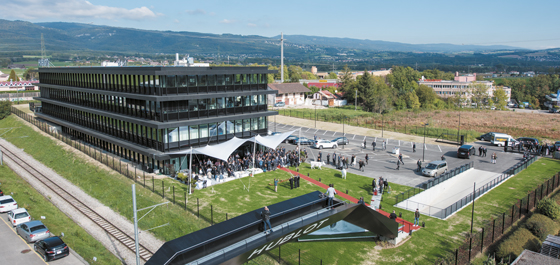
On 29 September the brand inaugurated its second building in Nyon, six years after the opening of the manufacture in 2009.
Flanked by brand ambassadors Bar Refaeli, Lapo Elkann and Pelé, the president and CEO of Hublot, respectively Jean-Claude Biver and Ricardo Guadalupe, hosted this event in the presence of more than 300 guests. The opening ceremony marked the start of a campaign celebrating the tenth anniversary of the iconic Big Bang.
Linked directly to the first site by a footbridge inspired by Formula 1 circuits, the new building, which cost the tidy sum of 20 million Swiss francs, covers an area of 8,000 square metres and will allow more than a hundred new jobs to be created over the next five years. To accompany Hublot’s growth, it is dedicated mainly to the manufacture of components for proprietary movements, as well as cases. Workshops for micro-engineering, decoration, electroplating, general mechanics and cleaning, among others, were moved into these new premises along with the after-sales service and part of the administration last August. The pre-existing building was reorganised at the same time, allowing the Innovation, Research and Development department to extend over the entire ground floor. The work of the latter focuses essentially on new materials and movements with grand complications. The ASF (component assembly), T1 (movement assembly) and T2/T3 (watch head and watch assembly) departments, as well as the complications workshop, have all been redeployed and can now expand to keep pace with the company’s growth. Jean-Claude Biver took this opportunity to announce the creation of a school of watchmaking, which will take up its quarters in the new building from 2017.
Lastly the production unit in Gland, which concentrates mainly on the manufacture of carbon fibre cases and components, as well as the jewel setting unit, have joined the main Nyon site.
With regard to sustainable development, Hublot has acquired two Private One recharging terminals which are available for both cars and scooters. The site will also be equipped with photovoltaic solar panels, allowing the production of renewable electrical energy. Particular attention was paid to technical installations in terms of their energy efficiency and performance. Regarding the energy concept, the structure of the building exceeds by 20% the efficiency requirements of standard SIA 380/1 (Swiss Society of Engineers and Architects). All technical installations were designed to comply with SIA standards.
October 22, 2015


 News
News